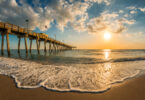The Canary Islands are a year-round island hopper’s destination. Sun worshipers can choose from hundreds of beaches to bask in temperate climes, while water sports enthusiasts can scuba dive, kayak, or sail. For those who prefer land-based activities, there’s horseback riding, golf, hiking, climbing or off-road biking. Nature lovers can enjoy stargazing, bird watching, whale watching or admiring the volcanic terrain. Basically, there’s something for everyone!
While there are seven large and six smaller islands off the coast of northwestern Africa, most visitors spend their time in Tenerife or Gran Canaria. Here’s what’s in store for you when you visit these fabulous islands:
Tenerife

Image via Flickr CC – Philippe Teuwen
Tenerife, the largest island in the archipelago, has two international airports — Los Rodeos Airport (North Airport) and Reina Sofia (South Airport). The capital city of Santa Cruz is situated in the northeast part of the island. The facets of city life — history, culture, shopping, restaurants and nightlife — are located here. It’s also a popular cruise ship port.
This city takes on a festive and jubilant personality during its famous carnival season in February or March (pictured above). If you want a more subdued vacation, you can relax at the nearby Playa de Las Teresitas in the village of San Andrés.
If you’re traveling with kids, there are plenty of things to do. Families can take day trips to the northwest coast to visit the Loro Parque (aquarium and zoo) and the Siam Park (water park). It’s best to arrive early because these popular venues are crowded during peak times.

Image by Sandy Bornstein
The focal point on the island is Mount Teide, the highest point in Spain. If you’re fascinated by craters and volcanoes, add Teide National Park to your “must see” list. While it’s advisable to make an online reservation for a cable car ticket and a permit to take the peak path, weather conditions are variable at higher altitudes. Those who don’t mind a bit of physical activity can hike instead of taking the cable car.

Image by Sandy Bornstein
Another option is to explore the nearby Pared de La Caldera de Las Cañadas, which was formed approximately 170,000 years ago after a landslide destroyed the top of Tenerife and is one of the largest cauldrons in the world.
Many of the best-known white sand beaches and resorts are located in the southern region whereas the northern beaches are characterized by volcanic black sand. The south tends to be sunnier, drier, and slightly warmer than the north. The relaxed beach scene is contrasted with a robust nightlife that’s saturated with bars, clubs and comedy performances.
You Might Also Enjoy: Escape the Winter Gloom at These Warm Weather Destinations
Gran Canaria
History buffs will recall that Christopher Columbus came to Gran Canaria on his way to discovering the New World. Modern day travelers come for a break from their daily lives. International flights land at the Las Palmas de Gran Canaria Airport and cruise passengers disembark at the Las Palmas Cruise Port. Most seek out one or more of the island’s black, gold, gravel or stone beaches.

Image via Flickr CC – Becks
By far the most notable beach is located on the southern tip at the Maspalomas Sand Dunes. Many consider it a miniature desert by the sea. Vendors provide camel rides. Be aware that there are designated areas for nudist, gay and lesbian beaches.
Some prefer to drive north in the northern region. Teror and Arucas offer historical landmarks and restaurants to taste local cuisine. Since the beginning of the 16th century, Christians have made pilgrimages to the Basilico del Pino in Teror. Admiring the workmanship of the handcrafted 16th century wooden balconies on the colonial styled two-storey buildings are an added bonus.

Upon entering Arucas, you can’t miss the Inglesia de San Juan Bautista (Church of San Juan Bautista). It towers above all of the nearby buildings. This neo-gothic-styled church appears out of sync with everything in the immediate vicinity. This structure would be more at home in a large city like Barcelona. Both towns have small shops and restaurants.
This volcanic island has several craters. Caldera de Bandama (Bandama Crater) is located near Arucas and Teror. This subtle crater can be viewed by standing on the hill overlooking the rim. The volcano rises almost 2,000 feet above sea level.

Image by Sandy Bornstein
Las Palmas de Gran Canaria is the largest European Union city outside the continent. This city is the host to an abundance of shops and restaurants. After touring the surrounding area, a stroll along the expansive Playa de las Canteras Beach promenade is a perfect way to end the day. If time allows, take a dip at one of the best urban beaches in the world.
FAQs:
Q: Can you see Tenerife from Gran Canaria?
A: While Tenerife and Gran Canaria are neighboring islands in the Canary archipelago, it is not possible to see one from the other. The distance between the two islands is approximately 80 kilometers (50 miles), and they are separated by the Atlantic Ocean. However, on a clear day, you may catch glimpses of the neighboring islands in the distance from certain elevated viewpoints.
Q: How do I get from Tenerife to Gran Canaria?
A: Traveling between Tenerife and Gran Canaria is convenient and accessible. The most common way to make this journey is by taking a ferry. There are regular ferry services that operate between the two islands, offering a comfortable and scenic journey across the Atlantic. The ferry ride usually takes around 1.5 to 2 hours, depending on the specific route and weather conditions.
Q: What are the best things to do in Gran Canaria in February?
A: February is a fantastic time to visit Gran Canaria, as the island enjoys mild temperatures and fewer crowds. Some of the best things to do in Gran Canaria during this month include exploring the charming towns of Puerto de Mogán and Teror, hiking in the scenic Agaete Valley, and taking advantage of the excellent conditions for water sports such as snorkeling and surfing. Additionally, February marks the annual Carnival celebrations in Las Palmas, where you can experience vibrant parades and festivities.
Q: Which is the main airport in the Canary Islands?
A: The main airport in the Canary Islands is Gran Canaria Airport (LPA). As the busiest airport in the archipelago, it serves as a major transportation hub for both domestic and international flights. Gran Canaria Airport offers excellent connectivity to various destinations within the Canary Islands and serves as the primary entry point for travelers visiting Gran Canaria.








